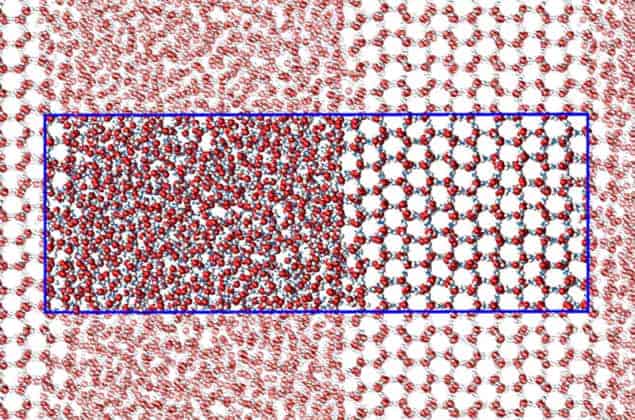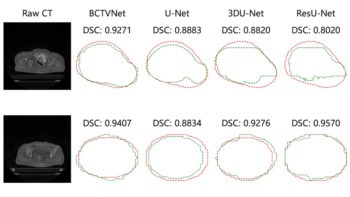
Artificial neural networks have been used to simulate interactions between water molecules and provide important clues about the remarkable properties of this live-giving substance. The study has been carried out by physicists in Germany and Austria, who used the networks to perform simulations 100,000 times faster than possible with conventional computers. Their work offers explanations for two key properties of water – its maximum density at 4 °C and its melting temperature – but the technique could be expanded to include other aspects of this ubiquitous substance.
Physicists and chemists have long found water’s unusual properties difficult to explain. Its density, for example, peaks at around 4 °C, which means that frozen water floats on liquid water – a property that is vital for aquatic creatures that have to survive in cold climates. Massive computer simulations have shown that hydrogen bonds between water molecules play a key role, but these simulations do not tell the whole story.
One key challenge is understanding the role of van der Waals interactions, which arise from quantum fluctuations in the electrical polarizations of water and other molecules. Van der Waals interactions have traditionally been hard to include in computer simulations, but Tobias Morawietz and colleagues at the Ruhr-Universität Bochum and the University of Vienna have now used artificial neural networks (ANNs) to model them in water. ANNs are computer algorithms that “learn” how to perform a specific task by being fed data related to that task. An ANN could, for example, learn how to recognize an individual’s face by being fed photographs of people and being told which images are of the target person.
Computationally expensive
In this latest research, Morawietz and his team fed the ANNs data from density functional theory (DFT) calculations of the interactions between water molecules. DFT is widely used to calculate the properties of molecules, but for interactions between water molecules, it can only provide an approximate result that must then be corrected to account for van der Waals interactions. Such calculations are also computationally expensive and so are normally done at just a few temperatures and pressures.
The problem is that to understand the density maximum of water, researchers need to do lots of calculations at different temperatures, which is too computationally intensive to be practical. The team therefore taught their ANNs using data from both van der Waals-corrected and uncorrected DFT calculations, which let the ANNs learn how van der Waals interactions affect the interactions between water molecules.
The ANNs were then used to calculate the properties of water in the temperature range from –100 to 90 °C, which they could do about 100,000 times faster than possible using DFT. Morawietz and colleagues were therefore able to determine the molecular structure of water over a range of temperatures and, then, infer the density of liquid water and ice.
Competing effects
The results reproduced the density maximum at 4 °C, which Morawietz says can be understood in terms of how van der Waals interactions affect the hydrogen bonding of water molecules. As liquid-water cools, the hydrogen bonds between a water molecule and its four nearest neighbours become stronger, pulling them together and making the water denser.
However, as the bonds strengthen, Morawietz says that this group of five molecules becomes more rigid – and so it becomes less likely that a surrounding water molecule can penetrate this tightly knit group. This has the opposite effect on density: as the temperature decreases, the hydrogen bonds become more rigid, allowing fewer water molecules to penetrate the group and so decreasing the density upon cooling.
According to Morawietz and colleagues, the ANN calculations show that van der Waals interactions moderate the rigidity of the hydrogen bonds, with these two competing density effects creating a maximum density at 4 °C. “van der Waals interactions crucially modify the hydrogen-bond network in water and give hydrogen bonds the right flexibility to exhibit a density maximum,” explains Morawietz.
He adds that the ANN calculations also show that van der Waals interactions make liquid water denser than ice at 4 °C, explaining why ice floats when it is formed. The calculations were also able to predict the melting temperature of ice.
Other approaches
Alan Soper of the Rutherford Appleton Laboratory in the UK told physicsworld.com that this research demonstrates clear progress in addressing the inability of DFT to simulate van der Waals interactions. However, he points out that several alternative computational approaches have been used and have delivered results that are comparable to those of Morawietz and colleagues.
Soper also points out that the discrepancy between the measured density of water and the calculated result is either 5 or 10% – depending on which DFT scheme the team used. While the team’s predictions for pressure and structure are much closer to experimental values, he says that a density discrepancy of less than 1% is needed to validate the model.
Morawietz says that the team is now adapting its technique to study proton transfer in water – an effect that is currently difficult to simulate but plays an important role in acid-base chemistry.
The simulations are described in Proceedings of the National Academies of Science.



